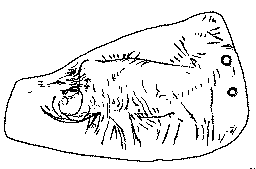 |
Science Frontiers ONLINE No. 61: Jan-Feb 1989 |
|
|
A Mammoth Fraud In Science
 The Holly Oak pendant, shown in the accompanying sketch, reveals a mammoth incised on a piece of seashell. Said to have
been discovered in 1864 at a Delaware archeological site, it has been employed to "prove" two different theories:
The Holly Oak pendant, shown in the accompanying sketch, reveals a mammoth incised on a piece of seashell. Said to have
been discovered in 1864 at a Delaware archeological site, it has been employed to "prove" two different theories:
- That humans were in North America as the Ice Ages waned and when mammoths still roamed the continent; and
- The the mammoth survived in North America well into the Christian era.
In an article in American Antiquity, J.B. Griffin et al marshall considerable evidence implying that the Holly Oak pendant is a fraud. Much of this contrary evidence seems weak:
- The discoverer of the pendant, H.Y. Cresson, was not highly regarded in American archeological circles of the time;
- The pendant was not taken seriously by other archeologists;
- The drawing of the mammoth "looks like" it was copied from an accepted European engraved tusk; and
- The shell from which the Holly Oak pendant was made "looks like" shells found in other archeological sites with more recent dates; and so on.
The only "hard" evidence that the pendant is a fake comes from radiocarbon dating, which suggests that the shell is only 1530 � 110 years old. The authors state that since mammoths positively did not survive that recently, the pendant must be a fraud.
Griffin et al thus dump the Holly Oak oendant into the archeological wastebasket of "proven" frauds. This rather large wastebasket, they say, also contains the Calaveras skull, the Davenport elephant pipes, the Lenape stone, and the Nampa Image!
(Griffin, James B., et al; "A Mammoth Fraud in Science," American Antiquity, 53:578, 1988. Also: Lewin, Roger; "Mammoth Fraud Exposed," Science, 242: 1246, 1988.)
Comment. We hate to see the Holly Oak pendant consigned to that infamous wastebasket, but the marks against it, soft as many of them are, are multitudinous. It could be resurrected as an anomaly if the radiocarbon date is shown to be grossly in error, as they sometimes are for seashells; or if the mammoth really did hang on it North America until fairly recent times. In our handbook Incredible Life, we have 10 pages of rather "soft" data that imply that the mammoths actually did survive the BC/AD transition.
Reference. The book Incredible Life is described here.
From Science Frontiers #61, JAN-FEB 1989. � 1989-2000 William R. Corliss